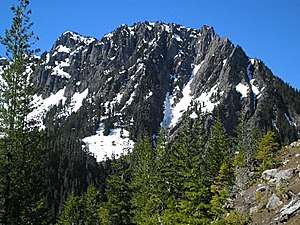Eagle Peak (Washington)
Eagle Peak is a 5,958-foot (1,816-metre) mountain summit on the west end of the Tatoosh Range which is a sub-range of the Cascade Range.[1] It's located south of Mount Rainier, within Mount Rainier National Park, and immediately east of Longmire. Eagle Peak was originally known as Simlayshe, a Native American word meaning eagle. George Longmire anglicized the name to Eagle Peak.[3] The four mile Eagle Peak Trail leads to views of Mount Rainier. The summit of Eagle Peak requires scrambling. Precipitation runoff on the peak drains into the Nisqually River.
| Eagle Peak | |
|---|---|
 Eagle Peak seen from Ricksecker Point | |
| Highest point | |
| Elevation | 5,958 ft (1,816 m) [1] |
| Prominence | 238 ft (73 m) [1] |
| Parent peak | Chutla Peak (6,020 ft)[2] |
| Isolation | 0.28 mi (0.45 km) [2] |
| Coordinates | 46°45′21″N 121°46′45″W [1] |
| Geography | |
 Eagle Peak Location in Washington | |
| Location | Mount Rainier National Park Lewis County, Washington, U.S. |
| Parent range | Cascades |
| Topo map | USGS Mount Rainier West |
| Climbing | |
| Easiest route | Scrambling class 3 |
Climate
Eagle Peak is located in the marine west coast climate zone of western North America.[4] Most weather fronts originate in the Pacific Ocean, and travel northeast toward the Cascade Mountains. As fronts approach, they are forced upward by the peaks of the Cascade Range (Orographic lift), causing them to drop their moisture in the form of rain or snowfall onto the Cascades. As a result, the west side of the North Cascades experiences high precipitation, especially during the winter months in the form of snowfall.[4] Due to its temperate climate and proximity to the Pacific Ocean, areas west of the Cascade Crest very rarely experience temperatures below 0 °F (−18 °C) or above 80 °F (27 °C).[4] During winter months, weather is usually cloudy, but, due to high pressure systems over the Pacific Ocean that intensify during summer months, there is often little or no cloud cover during the summer.[4] Because of maritime influence, snow tends to be wet and heavy, resulting in high avalanche danger.[4] The months July through September offer the most favorable weather for viewing or climbing this peak.
References
- "Eagle Peak, Washington". Peakbagger.com.
- "Eagle Peak - 5,958' WA". listsofjohn.com. Retrieved 2020-07-04.
- "Eagle Peak Trail - Mount Rainier National Park (U.S. National Park Service)".
- Beckey, Fred W. Cascade Alpine Guide, Climbing and High Routes. Seattle, WA: Mountaineers Books, 2008.
External links
- National Park Service web site: Mount Rainier National Park
- Washington Trails Association web site: Eagle Peak Trail
- Eagle Peak hiking: YouTube